The SSD Relapse: Understanding and Choosing the Best SSD
by Anand Lal Shimpi on August 30, 2009 12:00 AM EST- Posted in
- Storage
Intel's X25-M 34nm vs 50nm: Not as Straight Forward As You'd Think
It took me a while to understand exactly what Intel did with its latest drive, mostly because there are no docs publicly available on either the flash used in the drives or on the controller itself. Intel is always purposefully vague about important details, leaving everything up to clever phrasing of questions and guesswork with tests and numbers before you truly uncover what's going on. But after weeks with the drive, I think I've got it.
| X25-M Gen 1 | X25-M Gen 2 | |
| Flash Manufacturing Process | 50nm | 34nm |
| Flash Read Latency | 85 µs | 65 µs |
| Flash Write Latency | 115 µs | 85 µs |
| Random 4KB Reads | Up to 35K IOPS | Up to 35K IOPS |
| Random 4KB Writes | Up to 3.3K IOPS | Up to 6.6K IOPS (80GB) Up to 8.6K IOPS (160GB) |
| Sequential Read | Up to 250MB/s | Up to 250MB/s |
| Sequential Write | Up to 70MB/s | Up to 70MB/s |
| Halogen-free | No | Yes |
| Introductory Price | $345 (80GB) $600 - $700 (160GB) | $225 (80GB) $440 (160GB) |
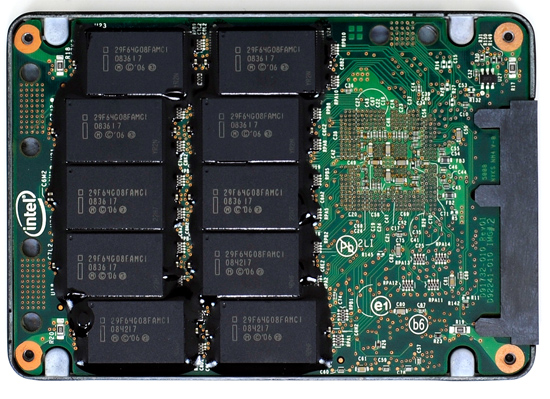
The old X25-M G1
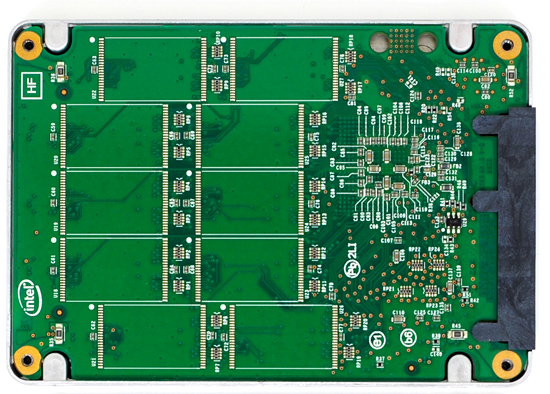
The new X25-M G2
Moving to 34nm flash let Intel drive the price of the X25-M to ultra competitive levels. It also gave Intel the opportunity to tune controller performance a bit. The architecture of the controller hasn't changed, but it is technically a different piece of silicon (that happens to be Halogen-free). What has changed is the firmware itself.

The old controller

The new controller
The new X25-M G2 has twice as much DRAM on-board as the previous drive. The old 160GB drive used a 16MB Samsung 166MHz SDRAM (CAS3):
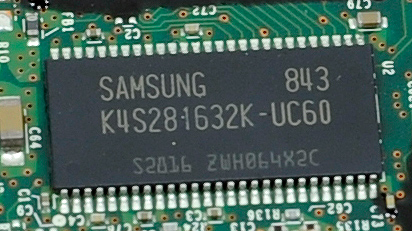
Goodbye Samsung
The new 160GB G2 drive uses a 32MB Micron 133MHz SDRAM (CAS3):
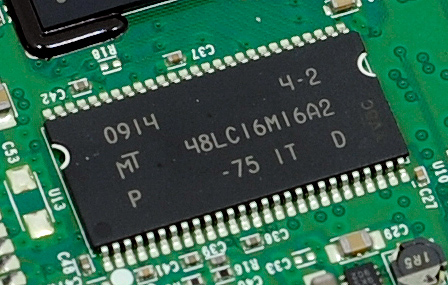
Hello Micron
More memory means that the drive can track more data and do a better job of keeping itself defragmented and well organized. We see this reflected in the "used" 4KB random write performance, which is around 50% higher than the previous drive.
Intel is now using 16GB flash packages instead of 8GB packages from the original drive. Once 34nm production really ramps up, Intel could outfit the back of the PCB with 10 more chips and deliver a 320GB drive. I wouldn't expect that anytime soon though.
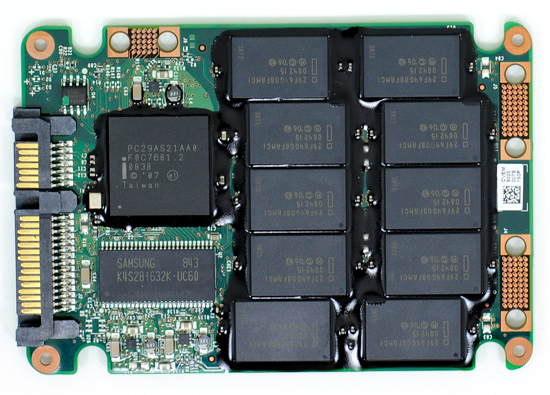
The old X25-M G1
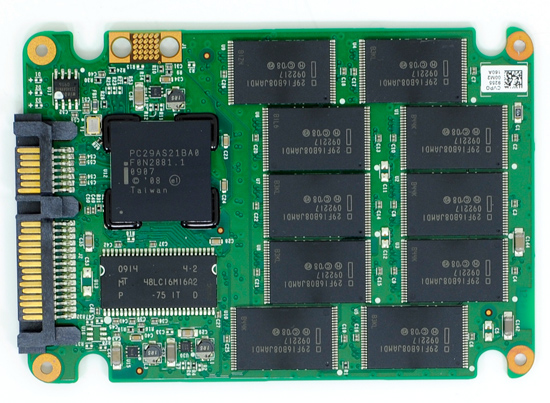
The new X25-M G2
Low level performance of the new drive ranges from no improvement to significant depending on the test:
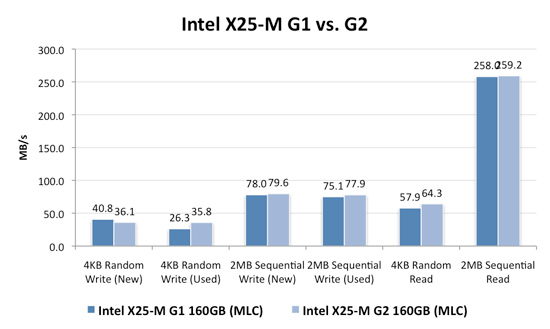
Note that these results are a bit different than my initial preview. I'm using the latest build of Iometer this time around, instead of the latest version from iometer.org. It does a better job filling the drives and produces more reliable test data in general.
The trend however is clear: the new G2 drive isn't that much faster. In fact, the G2 is slower than the G1 in my 4KB random write test when the drive is brand new. The benefit however is that the G2 doesn't drop in performance when used...at all. Yep, you read that right. In the most strenuous case for any SSD, the new G2 doesn't even break a sweat. That's...just...awesome.
The rest of the numbers are pretty much even, with the exception of 4KB random reads where the G2 is roughly 11% faster.
I continue to turn to PCMark Vantage as the closest indication to real world performance I can get for these SSDs, and it echoes my earlier sentiments:
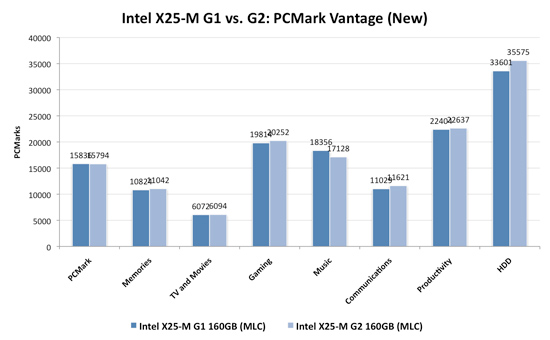
When brand new, the G1 and the G2 are very close in performance. There are some tests where the G2 is faster, others where the G1 is faster. The HDD suite shows the true potential of the G2 and even there we're only looking at a 5.6% performance gain.

It's in the used state that we see the G2 pull ahead a bit more, but still not drastic. The advantage in the HDD suite is around 7.5%, but the rest of the tests are very close. Obviously the major draw to the 34nm drives is their price, but that can't be all there is to it...can it?
The new drives come with TRIM support, albeit not out of the box. Sometime in Q4 of this year, Intel will offer a downloadable firmware that enables TRIM on only the 34nm drives. TRIM on these drives will perform much like TRIM does on the OCZ drives using Indilinx' manual TRIM tool - in other words, restoring performance to almost new.
Because it can more or less rely on being able to TRIM invalid data, the G2 firmware is noticeably different from what's used in the G1. In fact, if we slightly modify the way I tested in the Anthology I can actually get the G1 to outperform the G2 even in PCMark Vantage. In the Anthology, to test the used state of a drive I would first fill the drive then restore my test image onto it. The restore process helped to fragment the drive and make sure the spare-area got some use as well. If we take the same approach but instead of imaging the drive we perform a clean Windows install on it, we end up with a much more fragmented state; it's not a situation you should ever encounter since a fresh install of Windows should be performed on a clean, secure erased drive, but it does give me an excellent way to show exactly what I'm talking about with the G2:
| PCMark Vantage (New) | PCMark Vantage HDD (New) | PCMark Vantage (Fragmented + Used) | PCMark Vantage HDD (Fragmented + Used) | |
| Intel X25-M G1 | 15496 | 32365 | 14921 | 26271 |
| Intel X25-M G2 | 15925 | 33166 | 14622 | 24567 |
| G2 Advantage | 2.8% | 2.5% | -2.0% | -6.5% |
Something definitely changed with the way the G2 handles fragmentation, it doesn't deal with it as elegantly as the G1 did. I don't believe this is a step backwards though, Intel is clearly counting on TRIM to keep the drive from ever getting to the point that the G1 could get to. The tradeoff is most definitely performance and probably responsible for the G2's ability to maintain very high random write speeds even while used. I should mention that even without TRIM it's unlikely that the G2 will get to this performance state where it's actually slower than the G1; the test just helps to highlight that there are significant differences between the drives.
Overall the G2 is the better drive but it's support for TRIM that will ultimately ensure that. The G1 will degrade in performance over time, the G2 will only lose performance as you fill it with real data. I wonder what else Intel has decided to add to the new firmware...
I hate to say it but this is another example of Intel only delivering what it needs to in order to succeed. There's nothing that keeps the G1 from also having TRIM other than Intel being unwilling to invest the development time to make it happen. I'd be willing to assume that Intel already has TRIM working on the G1 internally and it simply chose not to validate the firmware for public release (an admittedly long process). But from Intel's perspective, why bother?
Even the G1, in its used state, is faster than the fastest Indilinx drive. In 4KB random writes the G1 is even faster than an SLC Indilinx drive. Intel doesn't need to touch the G1, the only thing faster than it is the G2. Still, I do wish that Intel would be generous to its loyal customers that shelled out $600 for the first X25-M. It just seems like the right thing to do. Sigh.










295 Comments
View All Comments
shabby - Monday, August 31, 2009 - link
The 80gig g2 is $399 now!gfody - Tuesday, September 1, 2009 - link
The gen2 80gb is at $499 as of 12:00AM PSTmaxfisher05 - Monday, August 31, 2009 - link
As of right now (8/31) newegg has the 160GB Intel G2 listed at $899!!!!!!!!!!!!!!!!!!! To quote Anand "lolqtfbbq!"siliq - Monday, August 31, 2009 - link
Great article! Love reading this. Thanks Anand.We gather from this article that all the pain-in-@$$ about SSDs come from the inconsistency between the size of the read-write page and the erase block. When SSDs are reading/writing a page it's 4K, but the minimum size of erasing operation is 512K. Just wondering is there any possibility that manufacturers can come up with NAND chips that allows controllers to directly erase a 4K page without all the extra hassles. What are the obstacles that prevent manufacturers from achieving this today?
bji - Tuesday, September 1, 2009 - link
It is my understanding that flash memory has already been pushed to its limit of efficiency in terms of silicon usage in order to allow for the lowest possible per-GB price. It is much cheaper to implement sophisticated controllers that hide the erase penalty as much as possible than it is to "fix" the issue in the flash memory itself.It is absolutely possible to make flash memory that has the characteristics you describe - 4K erase blocks - but it would require a very large number of extra gates in silicon and this would push the cost up per GB quite a bit. Just pulling numbers out of the air, let's say it would cost 2x as much per GB for flash with 4K erase blocks. People already complain about the high cost per GB of SSD drives (well I don't - because I don't steal software/music/movies so I have trouble filling even a 60 GB drive), I can't imagine that it would make market sense for any company to release an SSD based on flash memory that costs $7 per GB, especially when incredible performance can be achieved using standard flash, which is already highly optimized for price/performance/size as much as possible, as long as a sufficiently smart controller is used.
Also - you should read up on NOR flash. This is a different technology that already exists, that has small erase blocks and is probably just what you're asking for. However, it uses 66% more silicon area than equivalent NAND flash (the flash used in SSD drives), so it is at least 66% more expensive. And no one uses it in SSDs (or other types of flash drives AFAIK) for this reason.
bji - Tuesday, September 1, 2009 - link
Oh I just noticed in the Wikipedia article about NOR flash, that typical NOR flash erase block sizes are also 64, 128, or 256 KB. So the eraseblocks are just as problematic there as in NAND flash. However, NOR flash is more easily bit-addressable so would avoid some of the other penalties associated with NAND that the smart contollers have to work around.So to make a NAND or NOR flash with 4K eraseblocks would probably make them both 2X - 4X more expensive. No one is going to do that - it would push the price back out to where SSDs were not viable, just as they were a few years ago.
siliq - Tuesday, September 1, 2009 - link
Amazing answers! Thank you very muchmorrie - Monday, August 31, 2009 - link
My laptop is limited to 4 GB swap. While that's enough for 99% of Linux users, I don't shut down my laptop, it's used as a desktop with dozens of apps running and hundreds of browser tabs. Therefore, after a few months of uptime, memory usage climbs above 4 GB. I have two hard drives in the laptop, and set up a software raid0 1GB swap partition, but I went with software raid1 for the other swap partition. So once the ram is used up for swap, the laptop slows noticeably, but after the raid0 swap partition fills up, the raid1 partition really slows it down. Once that fills up, it hits swap files (non raid) which slow it down more. But thanks to the kernel and the way swappiness works, once about 4 GB of Ram plus about 3 GB of physical swap is used, it really slows. I can gain a bit of speed by adding some physical swap files to increase the ratio of physical swap to ram swap (thus changing swappiness through other means), but this only works for another 1 GB of ram.No lectures or advice please, on how I'm using up memory or about how 4GB is more than sufficient, my uptimes are in the hundreds of days on this laptop and thanks to ADD/limited attention span, intermittent printer availability for printing out saved browser tabs and other reasons (old habits dying hard being one), my memory usage is what it is.
So, the big question is, since the laptop has an eSATA port, can I install one of these ssd drives in an externel SATA tray, connected via eSATA to the laptop and move physical swap partitions to the ssd? I believe that swap on the ssd would be a lot faster even on the eSATA wire, than swap on the drives in the laptop (they're 7200 rpm drives btw). I'm aware that using the ssd for swap would shorten it's life, but if it lasts a year till faster laptops with more memory are available (and I get used to virtual machines and saving state so I can limit open browser windows), I'll be happy.
Buying two of the drives and using them raided in the laptop is too costly right now, when prices drop that'll be a solution for this current laptop.
Externel SSD over eSATA for Linux swap on a laptop? Faster than my current setup?
hpr - Monday, August 31, 2009 - link
Sounds like you have some very small memory leak going on there.Have you tried that Firefox plugin that enables you to have your tabs but it doesn't really have a tab open in memory.
TooManyTabs
https://addons.mozilla.org/en-US/firefox/addon/942...">https://addons.mozilla.org/en-US/firefox/addon/942...
Have fun filling up thousands of tabs and having low memory usage.
gstrickler - Monday, August 31, 2009 - link
You should be able to use an SSD in an eSATA case, and yes, it should be faster than using your internal 7200 RPM drives. You probably want to use an Intel SSD for that (see page 19 of the article and note that the Intel drives don't drop off dramatically with usage).If you don't need to storage of your two internal 7200 RPM drives (or if you can get a sufficiently large SSD), you might be better off replacing one of them with an SSD and reconsider how you're allocating all your storage.
As for printer availability, seems to me it would make more sense to use a CUPS based setup to create PDFs rather than having jobs sit in a print queue indefinitely. Then, print the PDFs at your convenience when you have a printer available. I don't know how your printing setup currently works, but it sounds like doing so would reduce your swap space usage.